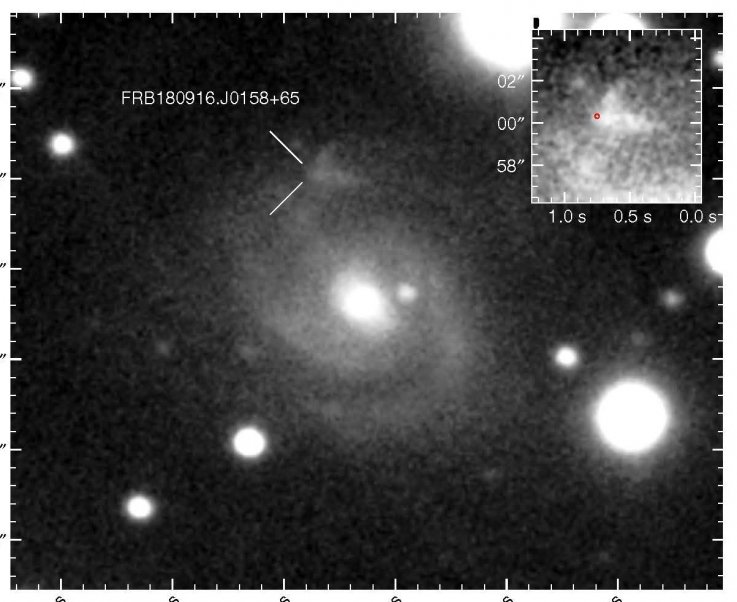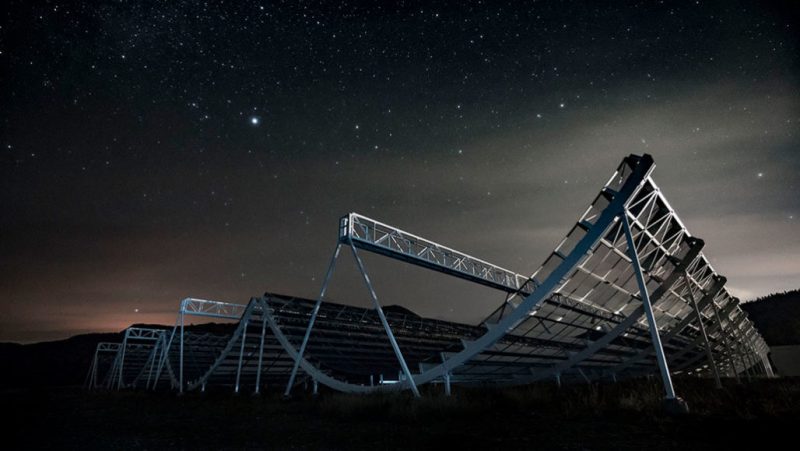
Fast radio bursts, or FRBs – brief but very powerful blasts of radio waves – are one of the most unusual phenomena ever discovered in deep space. Scientists don’t know what causes them. Most are just seen once, while a few have been seen to repeat. But none have been observed to repeat on a regular, cyclic basis. Until now.
As reported by Christopher Crockett in Science News on February 7, 2020, scientists using the Canadian Hydrogen Intensity Mapping Experiment (CHIME) radio telescope in British Columbia, Canada, have found that one of the repeaters does have regular bursts, in a cycle of about 16 days. This is the first time such regularity has been seen in an FRB. The discovery was made by Dongzi Li, an astrophysicist at the University of Toronto, and her colleagues.
The intriguing findings were published in a new peer-reviewed research paper on arXiv.org, on January 28, 2020.
From the paper:
We conclude that this is the first detected periodicity of any kind in an FRB source. The discovery of a 16.35-day periodicity in a repeating FRB source is an important clue to the nature of this object.

Duncan Lorimer, an astrophysicist at West Virginia University and co-discoverer of the first FRB, told Science News:
This is very significant. It’s potentially going to take us in an interesting direction to get to the bottom of these repeaters.
Other repeating FRBs had been observed to just repeat a couple times or so, which is interesting, but in itself still doesn’t explain what is causing them. Even less so with FRBs that are only seen once and then are gone.
If all FRBs were sporadic, one time only events, that might suggest a random, cataclysmic origin, perhaps something like supernovae. The repeaters make that idea much less likely. Now, with the fact that one is known to repeat on a regular basis, the implication is that something is controlling or modulating the bursts. But what could it be?
The pattern is an odd one; CHIME observed one to two bursts per hour, a process that continued for four days. But then, for the next 12 days or so, there was no activity at all. The cycle then repeated.

Some 28 bursts were recorded by CHIME in total for this FRB, called FRB 180916.J0158+65, from September 16, 2018, to October 26, 2019. This FRB is in a spiral galaxy 500 million light-years away. That is a very long way from Earth, but it is actually the closest known FRB found so far. The identification of the specific location was previously published in Nature on January 6, 2020.
So what could create this kind of periodicity? One possibility is that there is something else paired with the FRB, as a binary. Perhaps the FRB is orbiting another object? In that case, the signals from the FRB could get interrupted when the other body obstructs them, as viewed from Earth. Stellar winds from a companion body might also interrupt the signals periodically. A supermassive black hole companion was also considered, but seemed unlikely since the FRB is in the outskirts of its galaxy, and they tend to be found in the centers of galaxies. A lower-mass black hole could still be possible, however. All of these scenarios are just theories at this point.
As Lorimer also told Aristos Georgiou at Newsweek:
I was surprised to see a periodicity in the outburst windows. I think the result is really interesting in that regard. I was thinking more in terms of a periodicity in the arrival times of the pulses themselves. I think these new results hint at some sort of orbital phenomenon that is driving this behavior.
Another new paper suggests a binary star system with a massive star and a highly magnetized type of neutron star called a magnetar. But known magnetars, in our galaxy at least, spin extremely fast, once every second or less. That’s a big difference from a 16-day cycle for a rotating object. Other neutron stars spin about once every one to ten seconds.

The FRB could still be a singular object that is rotating or wobbling, but that doesn’t fit the data very well, according to the researchers.
The researchers are hoping that additional periodic FRBs will be discovered as well. According to Lorimer:
There’s nothing particularly special about this repeater. The fact that they detected periodicity on this one hints that other ones will have periodicity as well.
The first known FRB, called FRB 010724 or the Lorimer Burst, was found in 2007, in data from the Parkes radio telescope in Australia.
The FRB Catalogue currently has 110 FRBs listed and discovered so far. As the name implies, FRBs are transient radio bursts lasting only a fraction of a millisecond to a few milliseconds at most. They are thought to be of extragalactic origin – beyond our Milky Way galaxy – and have been detected in many parts of the sky by radio telescopes.
Two other repeating FRBs have been previously detected, including by CHIME, but no long-term regular periodicity has been observed for them, not yet anyway. Their bursts appear to be more random. This suggests that even repeating FRBs may differ from each other in significant ways, and there may be multiple ways to produce FRBs in general. In a previous article for New Scientist, CHIME team member Shriharsh Tendulkar had stated:
This demonstrates that there is a vast diversity even in what the repeaters are. Maybe some of them are older, some of them have stronger magnetic fields, they’re in different environments.

While FRBs are probably a natural phenomenon, like pulsars, it is tempting to wonder if they could be from an extraterrestrial intelligence. The newly-discovered periodicity in this one FRB is intriguing, but isn’t proof in itself. The fact that they originate from so many different places among other galaxies would seem to argue against them simply being from a single advanced civilization. But even if they are natural, they must be a type of exotic phenomena never seen before, and utterly new to science, and that is exciting.
Bottom line: For the first time, a fast radio burst has been found to be repeating, in a regular 16-day cycle.
Source: Periodic activity from a fast radio burst source
Source: A repeating fast radio burst source localized to a nearby spiral galaxy











